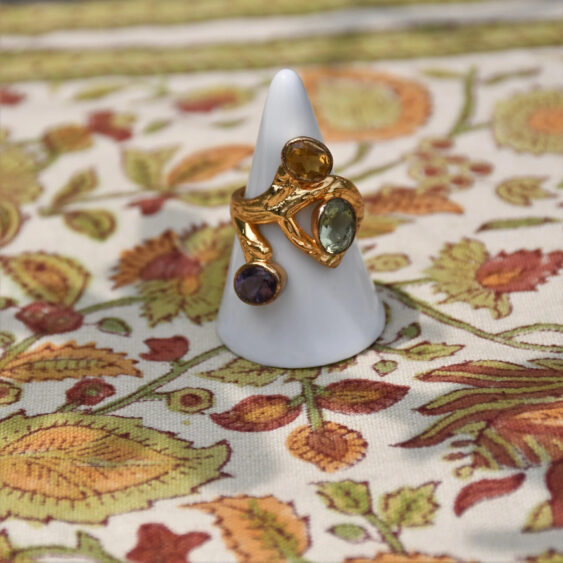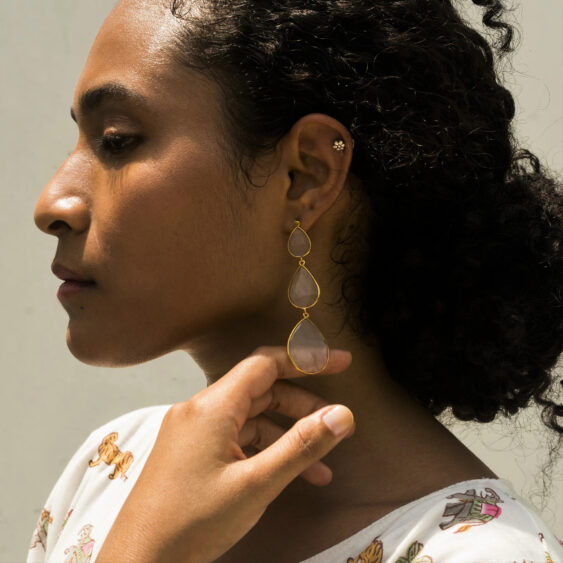Arjun Bahl
by Manica Pathak
At the intersection of art, culture, and urban spaces, Arjun Bahl’s ventures—from St+art India to immersive brand studios—are reshaping how India experiences art in everyday environments.
Delhi-based creative entrepreneur Arjun Bahl has emerged as one of the defining voices within India’s contemporary art scene, one that is currently headed towards a global stage. With roots in India’s early music and events scene, what sets Arjun Bahl’s trajectory apart is the way each chapter of his multidisciplinary journey has informed the next, ultimately shaping the country’s public art movement with both creative conviction and cultural sensitivity. Today, he has added several art-led ventures to his portfolio, including a gallery, creative studios focused on brand storytelling, attracting global clients and is widely recognised as the co-founder of St+art India, an initiative that is redefining how art is experienced in public spaces. The true force of Arjun’s works lies in how, within a country steeped in artistic heritage, he has reignited a collective awareness of art’s ability to shape public consciousness, shift perspectives, and transform everyday environments. His deep understanding of the creative ecosystem has cemented his position as a prominent voice in the industry. With a degree in Music Business from the University of Westminster and a Master’s in Events and Tourism Management from Bournemouth University, he returned to India just as the country’s independent music scene was beginning to find its voice. Through Crayon Events & Entertainment, he helped build some of the earliest platforms for live acts and festivals, carving out space for a generation of homegrown talent. However, the vision didn’t end with programming; Arjun’s curiosity naturally extended to how physical spaces could enhance those experiences. In 2007, he launched Most Technical India, a playground for sensory innovation, where immersive technologies like projection mapping and modular lighting became tools to rethink how performance venues could feel, behave, and connect. In 2014, Arjun co-founded St+art India, a non-profit organisation aimed at making art accessible in shared spaces, from metro stations and streets to dockyards and government buildings.

Under his leadership, the initiative has developed seven Public Art Districts, hosted over 25 multi-format festivals, including the notable Mumbai Urban Art Festival in 2022–23, and produced three editions of St+art Care, while building an ever-expanding portfolio of projects rooted in community engagement and collaboration. From policy advocacy and civic partnerships to artist residencies and site-specific installations, St+art has become a touchpoint for inclusive storytelling and cross-cultural dialogue. His current practice moves fluidly between public and private formats. As the co-founder of XXL Collective and Gallery XXL, he works with Indian and international artists to create contextually relevant, large-scale interventions. Recent collaborations led by Arjun and St+art include the Mumbai Urban Art Festival, held from 12 December 2022 to 22 February 2023, which featured over 60 artists across 11 locations in the city. The festival drew over 300,000 visitors and hosted 150+ public events, including performances, workshops, curated walks, and talks. In March 2023, St+art curated and produced a two-day festival at Lodhi Art District for the Kiran Nadar Museum of Art (KNMA), activating the space through murals, performances, guided tours, and workshops that re-energised public engagement with India’s first art district. With Guerrilla Art & Design, his work extends into immersive brand experiences, shaping campaigns and environments for names like Adidas, Facebook, Nike, Uniqlo, Social, and Taco Bell. Across a two-decade career, Arjun has produced over 300 events and booked more than 500 artists. But what continues to drive him is a consistent curiosity about space; how it’s built, felt, remembered, and how art, when thoughtfully embedded into the everyday, can invite us to experience the world a little differently.
Arjun speaks to Blur The Border:
BTB: You studied Music Business and Events & Tourism Management, both niche fields at the time. What drew you to those paths early on?
Arjun: I started early, right after school, by promoting electronic music gigs. At the time, the Asian underground scene was rising, especially out of the UK, with artists like Talvin Singh making waves. I got drawn in further through friends like the Midival Punditz, who are music producers. Since I was too young to get into venues on my own, I found my way in by working at events, collecting data like emails and phone numbers for SMS marketing. That’s how I began understanding the business side of music while still in school and college.
Very early on, I knew that music and events were the direction I wanted to pursue. Around 2002, we began developing what would become Elevate. For this, we collaborated with Dave Parry from the UK, known for building the Ministry of Sound and Fabric. These are two venues that significantly influenced the electronic music scene in Europe. He also worked on Matter in London and White in Dubai. At Elevate, he designed the AV system, which marked an important shift in how we approached sound and experience.
We opened the club in 2004, one of India’s early superclubs, with a capacity of over 1,500 people and spread across 15,000 square feet on three floors. It included a body-sonic dancefloor and a Martin Audio sound system, managed through the TiMax Sound Hub and Outboard Electronics for spatial sound control. From the outset, Elevate aimed to bring both international and domestic artists to Indian audiences and played a role in building a community around electronic music. As platforms like Sunburn and Submerge emerged, they continued this momentum. Elevate regularly hosted performances with artists like Nikhil Chinapa and Hermit Sethi, who were active in growing the scene.
In 2006, DJ Mag listed Elevate among the top 35 nightclubs globally, recognising its contribution during a key phase in India’s evolving music landscape. During that time, while working for Elevate, I also pursued a master’s in Events and Tourism Management in the UK, wanting to deepen my understanding of the industry, and went on to complete a second degree in Music Business at the University of Westminster. This was around 2004–2005, when niche programs in music and events were still rare. Few places offered serious academic pathways into this world, such as Australia was ahead, especially in sports management, music production, but most people didn’t see event management as a “real” field back then.
Although I wanted to understand its full spectrum, from creative vision to backend logistics, and was lucky enough to study alongside peers who now work at Universal, Sony, and major global agencies, many of whom are still close friends. At the heart of it, I’ve always been driven by the intersection of music, live experiences, and how it all comes together behind the scenes. That’s what keeps me excited.
BTB: How did those experiences shape your creative approach to initiatives like St+art India?
Arjun: I’m not sure if St+art India began by design or accident; it came much later. Back in 2006, I had already started my events company, Crayon Events and Entertainment, and worked on several large-scale projects. By 2012–13, I had met many of my early goals, building a network of nightclubs under Most Technical India (MTI), which I co-founded with Dave Parry and Isa Sapin. MTI was a subsidiary of Most Technical, UK, and through it, we developed clubs like Kismet, Kitty Su, Agni, Shiro, and Some House Room. Over time, we worked with more than 300 music and performance artists, and also brought private international acts like Cirque Éloize (a subsidiary of Cirque du Soleil) to India.
But despite the scale and success, something felt missing. Most of the work was client-led, and even with the creative freedom, I felt the need to channel my deeper interest in visual culture. I’ve always been drawn to graphic design, visual direction, and art, though I’m not an artist myself. That creative pull eventually led me to Hanif Kureshi, who became a close friend and collaborator. We met during his stint at Wieden & Kennedy and while working on the launch of Heineken in India.
At some point, Hanif told me he wanted to leave the agency world and start a street art festival and his own underground design firm, and I didn’t know much about street art then. But the idea of using public space for creative expression really resonated with me. Hanif suggested we team up; I could handle management and funding, and he would lead the artistic direction. That early collaboration laid the foundation for something larger. Hanif introduced me to Giulia and Akshat, and I connected with Thanish. Eventually, the five of us co-founded St+art India Foundation, launching our first festival in Delhi with projects in Hauz Khas Village, Shahpur Jat, ITO, and Tihar Jail. Our first experiential exhibition in Hauz Khas Village was hosted in a space that would later become the second Social. Working in public spaces, creating something accessible and community-driven, completely shifted my approach. It felt like a natural evolution, from shaping experiences in clubs and events to shaping conversations in the public domain through art.

St+art Care, Vadodara, 2025
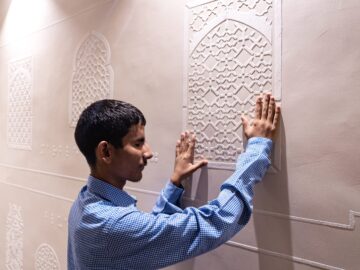
St+art Care, Jaipur, 2023
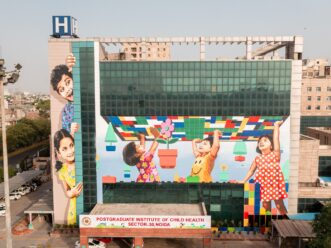
St+art Care, Noida, 2022
BTB: In St+art’s early years, what kind of resistance did you face, whether from institutions, the public, or even the creative community? How have those perceptions changed over time?
Arjun: Any new idea faces resistance, especially when there's no precedent, and that was certainly true in our case. Different stakeholders posed different kinds of challenges. When we identified areas to work in, we first had to seek permission from building owners, then engage the local community, and many were sceptical. Some thought we were doing brand advertising, like painting a Coca-Cola sign and asked, “Why are you doing this? What’s the catch?” But once they saw the artists at work, he began scaffolding going up, the sheer effort put into every mural, they realised we weren’t selling anything. We were creating something for them. That scepticism slowly turned into trust. People who once said, “Don’t paint our walls” began asking, “Can you do ours next?” They started inviting us in for tea. It was a beautiful transformation. We also made it a point to integrate the neighbourhood’s stories and histories into the artwork. That emotional connection helped build respect and belonging, and ultimately, ownership.
Another major challenge was navigating bureaucracy. At the time, there were no clear protocols for public art. I remember approaching the Delhi Police for permission to paint a large portrait of Gandhi on their headquarters. When we asked who to speak with, the response was, “We don’t know either.” Together, we worked through this uncharted space and developed a working framework.
Over time, that process began to shift institutional thinking. Public art moved from being a peripheral idea to becoming part of the larger conversation. It started gaining recognition as a tool for urban change. Around the same period, the government’s Smart City mission was launched, and gradually, public art began aligning with broader urban development goals.
Today, there are more wall offers than we can accept. Cities are waking up to the value of art in public spaces. We’re not just building infrastructure anymore; we’re starting to think about how people feel in those spaces. And that’s where artists play a unique role, offering imagination, context, and cultural depth that planners might overlook. That thinking led to our vision of a public art district, spaces that are pedestrian-friendly, vibrant, and rooted in community. Places like Lodhi Art District aren’t just beautiful; they’re walkable, livable, and human, allowing for festivals, workshops, street conversations–things that truly animate a city. So yes, we faced resistance that was creative, cultural, and institutional. But we were lucky to find progressive officers who saw the potential. Our mission has always been simple: do something different in the city—through art, with the community and for the city.
BTB: India has no shortage of creative talent, but often lacks the infrastructure to support it. What do you think is needed to build a more cohesive and future-ready creative ecosystem?
Arjun: The first step is to define and consolidate the creative industries within a clear, recognised framework. India still lacks a formal understanding of what constitutes the creative economy in our context, but that’s changing. The government is beginning to see the sector’s potential, especially as a form of soft power. We can take cues from countries like the UK, where creative industries fashion, architecture, art, urban design, and crafts are officially recognised, which unlocks specific benefits and strengthens the ecosystem, eventually encouraging interdisciplinary collaboration. If someone working in visual art wants to collaborate with a weaver or a designer, there’s a structure to support that. So, once these industries are brought under one umbrella, it opens the door to policy reforms, taxation, ease of doing business, grant access, international collaborations, and deeper investment in skill development. The creative economy already exists and thrives informally. It just needs to be channelled and supported formally.
On the infrastructure side, there’s encouraging momentum. Private players like Asian Paints, a long-term vision partner of St+art, have provided consistent and meaningful support, not just to us but to hundreds of organisations working across architecture, urban design, visual arts, and culture. Institutions like KNMA have also been active in this space, and several new foundations and cultural venues are emerging. KNMA is currently developing a major performing arts centre and museum in Delhi. NMACC opened recently, MAP launched in Bangalore, and the BRIJ is expected to open in the next two years. Meanwhile, Hampi Art Lab has been running robust residency programs and is led by one of India’s most committed patrons of the arts. These are significant steps forward. We have seen more spaces open up, which are now dedicated to exhibitions, performances, and artist residencies. This growth in infrastructure is crucial because it gives artists places to develop and present their work. But we still need more—more museums, more public venues, more investment in cultural institutions.
Compared to the global context, India is still under-resourced, especially considering the size and diversity of our population. But that’s okay. We’re a young country, just 75 years old, and we’ve had to rebuild from scratch in many ways. That said, we’re moving in the right direction. The momentum is real, and I believe the future is bright for both the creative and cultural industries.
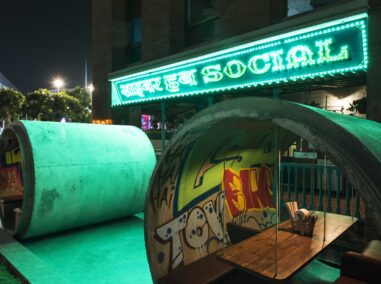
Cyber Hub Social
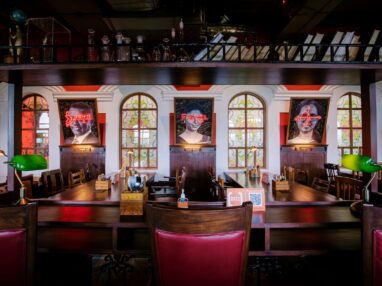
Dehradun Social
BTB: And beyond public art, through XXL Collective and Guerrilla Art & Design, you’ve brought art into brand storytelling and marketing. So, how do you encourage them to move beyond marketing and engage more meaningfully with cultural storytelling and public experience?
Arjun: That’s actually one of our core strengths, bringing art into brand experiences through spatial design and storytelling. We’ve done a range of projects, including many with Social, and every element in those spaces is intentional. It’s raw, almost anti-design in spirit, especially when we first launched it. Today, there are over 50 Social outlets across the country, and each one feels distinct. Even the typography was a deliberate choice. We used stencil fonts inspired by street signage, the kind you see on electricity boards that say “High Voltage, Do Not Touch.” It’s rooted in the everyday visual culture of Indian cities. That decision alone brought a street-art language into the heart of a commercial brand.
But it went far beyond that. Hidden messages, how the bill is presented, the design of the menus, every detail was infused with art. Each outlet is hyperlocal by design. We deliberately moved away from a templated, cookie-cutter approach. That philosophy extends to other projects too, whether it’s Taco Bell, or workspaces we have done for brands like Facebook, Prët à Manger, Adidas and PhonePe. In every case, we try to embed art in a way that’s relevant and meaningful to the space, not just decorative. And that’s really what we love doing, mixing things up, challenging norms, and creating spaces where art doesn’t just exist, but shapes how people experience a brand.
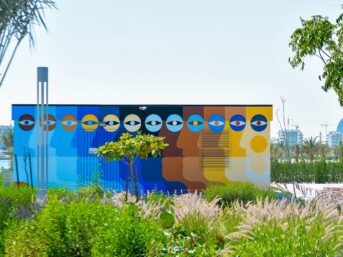
Yas Bay, Abu Dhabi
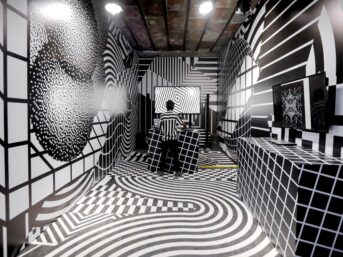
HP Z Series Launch
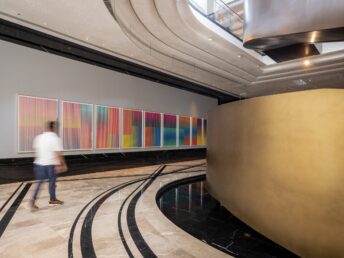
DLF Camelias
BTB: With the rise of AI platforms and new digital tools, how do you see the creative economy shifting? What role can artists and brands play in shaping this evolution rather than reacting to it?
Arjun: Honestly, we see AI and other digital tools as complementary to what we do. They’re just tools, like the internet was. I don’t think they’ll make creative jobs redundant. I don’t think artists or designers are going anywhere. If anything, these tools help us save time and make processes more efficient. For instance, if we’re discussing a visual direction with a brand, these tools can help us generate references quickly. But the actual execution, the final creative work, is still original and still very much human. It’s similar to how research changed when the internet came around. We no longer had to go to libraries for everything. Information was at our fingertips. This is just the next iteration of that. Yes, we’re aware of potential issues like copyright or misuse, but we use these tools mindfully. And right now, they just help us ideate better and faster.
BTB: As a creative entrepreneur, how does your environment impact your work and fuel your creativity?
Arjun: It’s definitely important. For us, the streets are our studio and there’s something incredibly energising about that. It’s all about perspective. You can look at a street and see chaos, noise, clutter, unpredictability. Or you can see layers of culture, color, and life. That’s what inspires us.
There’s beauty in the messiness of urban India, hand-painted signboards, the fading walls, and the rhythm of people going about their day. That rawness feeds our work.
At the same time, we’re fortunate to have creative spaces to retreat to. Our Delhi office is surrounded by trees, and the one in Goa is in an old Portuguese house that has that texture and character that sparks ideas. And then there are places like Sassoon Dock, where we’ve worked for months during our festivals. It’s a functioning fishing dock, filled with sounds, smells, and people, intense but deeply inspiring.
So for me, inspiration comes from contrast. Nature offers calm and clarity, the city gives energy and grit. It’s less about needing a perfect space and more about being open to what each environment can offer creatively.
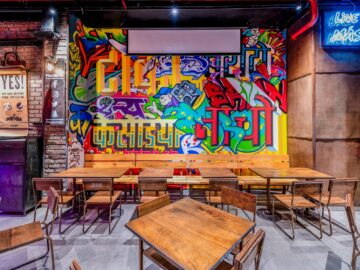
Taco Bell, Nehru Place, New Delhi
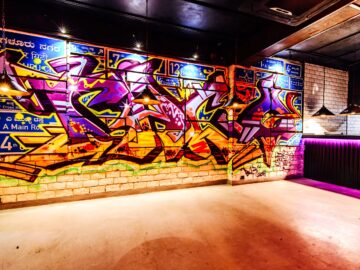
Taco Bell, Indira Nagar, Bangalore
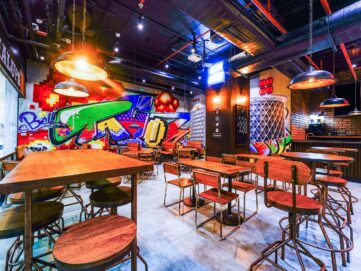
Taco Bell, Hi-Tech, Hyderabad
BTB: And as creatives, we all have certain processes or rituals that help us get into a productive headspace. Do you have any personal habits or rituals that help you get your creative juices flowing?
Arjun: I’ve never really thought about it that way. For me, the only real ritual is being excited about the project I’m working on. If I’m excited, I can work day and night. It doesn’t matter where or how. I’ve been fortunate that I’ve mostly been able to choose the projects I want to do, and I’ve built my life around this work. That keeps me energised. Of course, I’m always looking to take on new and interesting projects, something that adds value to what we do as a foundation, and something that excites the team, too.
BTB: If you were to collaborate with other artists, outside of your discipline, what is one collaboration you would love to do?
Arjun: Well, not too sure about outside our discipline, but given the chance, I would love to collaborate with the prolific Icelandic-Danish artist Olafur Eliasson.
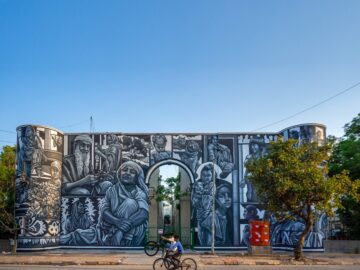
Paola reveals Lodhi Colony, St+art X KNMA Delhi 2023

Zero reveals St+Art Lodhi 2020

Gond Art Residency

